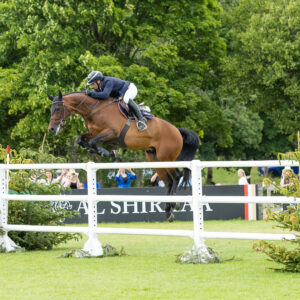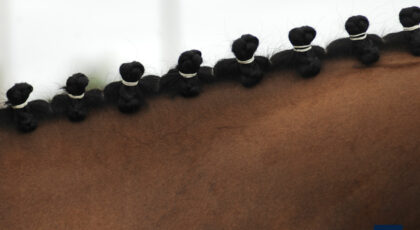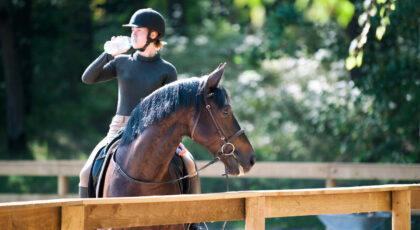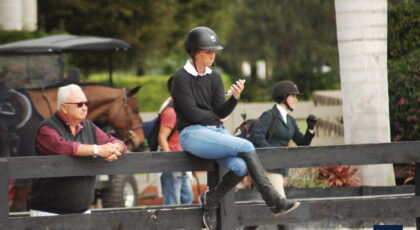On Friday, February 11th, management at Desert International Horse Park (DIHP) first reported an Equine Herpesvirus 1 (EHV-1) infection on the property of the Thermal, CA showground.
EHV‐1 virus is endemic in the horse population and a relatively common cause of mild respiratory disease, typically characterized by fever and nasal discharge. In some cases, horses with EHV-1 may develop neurological symptoms or Equine Herpes Myeloencephalopathy (EHM), a potentially life threatening disease.
According to the American Association of Equine Practitioners, “It is unknown why this virus produces the neurological form in some horses. Horses that have had EHV‐1 may be carriers and the virus may be latent and reoccur under periods of stress such as transport or a new activity.”
Fever is often the only warning sign with the neurologic form. EHV-1 typically causes a biphasic (two phase) fever—the horse will have fever on day 1 or 2 and again on day 6 or 7. Neurological signs may not present until the second fever and some horses may not develop a fever at all. Clinical signs of the neurologic disease appear suddenly and usually progress rapidly, reaching peak intensity within 24 to 48 hours. These may include depression, incoordination, hind limb weakness, loss of tail or bladder tone and dog sitting position.
In the days since EHV-1 was detected at the horse park, DIHP has been working closely with vets at the California Department of Food and Agriculture (CDFA), the head vet at US Equestrian and the veterinary team at East-West to minimize and contain the spread of the virus and to communicate regular updates of the events unfolding via internal and USEF press releases and the CDFA website.
Here’s the timeline of events so far.
Friday, Feb 11
DIHP and CDFA confirm two cases of EHV-1 Non Neurologic and one case of Equine Herpes Myeloencephalopathy (EHM) in a 12-year-old Zangersheide gelding at the horse park. The three horses are immediately isolated and quarantined and Barn 34, the tent where the three horses were located, is placed under mandatory quarantine.
CDFA staff conducts a site assessment and assists in implementation of enhanced biosecurity measures, including twice daily temperature monitoring. Testing begins on any horse with an elevated temperature.
Tuesday, Feb 15
Two more horses in Barn 34 test positive, after displaying fever but no neurological signs, bringing the total to five. Four horses in three additional barns report elevated temperatures and are tested, all of which come back negative. CDFA continues to be on-site to monitor the situation.
Thursday, Feb 17
The five horses in isolation from Barn 34 are reported as doing well and asymptomatic. One additional horse in Barn 6 tests positive for EHV-1. This horse first reported a fever on Friday and tested negative, but came back positive after being re-tested for a broader respiratory panel that also included EHV-1. The horse is placed in isolation and the exposed cohort in Barn 6 is placed in quarantine in a new tent in a separate area of the horse park.
Friday, Feb 18
The veterinary teams at USEF, on the ground at East-West, and at the CDFA advise competitors at DIHP to “stay put and hunker down” to avoid any potential spread of EHV-1. DIHP closes access to new arrivals and daily haul-in horses and riders at the horse park until further notice and announces it will not run the CSI3* event previously scheduled for Feb 23–28.
Two previous fever-only horses develop neurologic symptoms and are confirmed as EHM cases. One is euthanized due to the severity of the clinical signs. CDFA continues to be on site at the premises, actively monitoring the situation.
Saturday, Feb 19
Two horses outside the quarantine barns are identified with EHV-1 and immediately isolated. All horses in the exposed cohorts are isolated and quarantined on the property. EHV-1 situation at the horse park deemed “very serious” and evolving on an “almost hourly” basis. Of the three original horses in isolation, two now test negative.
To date, there have been three confirmed EHM cases (EHV-1 infection with neurological signs) and five confirmed EHV-1 fever-only cases at the horse park. CDFA continues to be on site at the premises.
Said President and CEO Steve Hankin in a release on Saturday: “Our focus has been and will continue to be on doing everything possible, at the direction of CDFA and USEF, to end the infection on the property. We will spare no expense or effort to bring this to a conclusion as rapidly as possible. While we will try and communicate as often as we can, at times our focus is on addressing the immediate requirements to isolate and segregate horses as rapidly as possible when fevers and/or infection are identified. During those times, broader communication from us can be delayed, but the CDFA website is always up to date.”
Sunday, Feb 20
CDFA reiterates call for strict adherence to bioscecurity protocols at DIHP to reduce the risk of ongoing disease transmission and strongly advises any non-quarantined horses leaving the horse park to be isolated at least 30 feet from all other equids and monitored with twice daily temperature checks for at least 7 days. Owners asked to consider refraining from entering a large horse facility or event for 14 days out of an abundance of caution.
Monday, Feb 21
Horses in isolation, pre-isolation, and quarantine remained stable. Results on ten samples confirm four new positive tests for EHV-1, including one retest of a previously reported initial negative test. Six tests come back negative. Horses that initially test negative after fever or clinical signs are retested for potential delayed viral shedding.
Two new horses with elevated temperatures are tested.
DIHP cancels Week 5 horse show and schedules dedicated rings for each barn/trainer cohort to school horses to avoid any exposure to horses outside of their barn/trainer cohort. Updated protocols are made available in English and Spanish.
Tuesday, Feb 22
Result from one horse with elevated temperature is negative. Second horse’s results are pending. No other horses are identified with fevers that required testing.
DIHP submits ten swabs to the CDFA for retesting—four of horses that have tested negative thus far to identify potential delayed shedding and six of horses that previously tested positive to determine current EHV-1 status.
Wednesday, Feb 23
Results of 11 tests from Tuesday confirm three new cases of EHV-1 outside of the index quarantine barn at DIHP, including two horses that previously tested negative and one that was tested for the first time after spiking a fever. All three of the initial cases on the property now test negative. Five additional tests for horses with initial fevers are submitted to the CDFA.
Three horses that had attended DIHP and returned to their home barns in Santa Barbara, Ventura and San Mateo counties are confirmed positive for EHV-1, displaying fever only with no neurologic signs.
To date, there have been three confirmed EHM cases (EHV-1 infection with neurological signs) and 16 confirmed EHV-1 fever-only cases associated with this incident. CDFA continues to be on site at the horse park to actively monitor the situation and retesting is ongoing.
Thursday, Feb 24
Two new horses located in Los Angeles and Riverside counties are confirmed positive for EHV-1, displaying fever only with no neurologic signs. Both had attended DIHP and returned to their home premises, or were exposed to horses that had returned home from DIHP.
No new cases are reported at the Horse Park.
Friday, Feb 25
One horse that had attended DIHP and had subsequently returned to their home premises is confirmed for EHV-1, displaying fever only. The positive horse had previously been isolated and has been quarantined, along with the exposed cohort.
One additional horse at DIHP, outside of the quarantine barn, is confirmed positive for EHV-1, displaying fever only with no neurologic signs.
Four new horses report elevated temperatures and are currently being tested.
This is a developing story will be updated as new information becomes available.
Additional Resources:


 February 20, 2022
February 20, 2022 
























